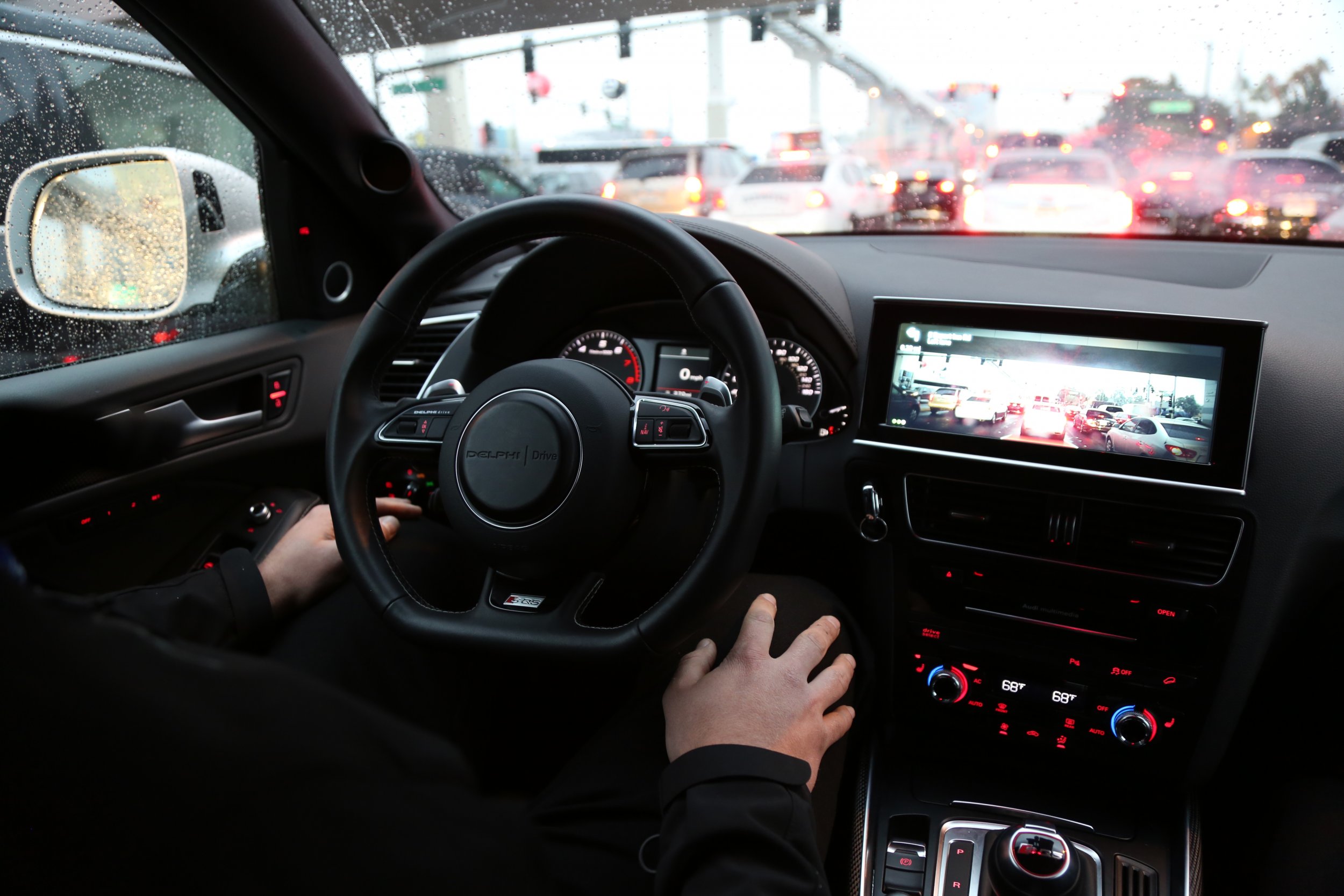
There's a small box that costs a few hundred dollars, fits nicely behind your rearview mirror, and would stop thousands of deadly accidents a year. Vehicle-to-vehicle communication or V2V is ready for your car now, but sadly, it won't be saving lives for years, and maybe even longer than a decade.
Delphi, an automotive parts company, wowed CES with a self-driving car last year. At the 2016 Vegas show, they took attendees even further into the future, when cars will be able to talk to each other and to infrastructure like stoplights.
Under a surprise rainstorm, an Audi outfitted by Delphi drives itself around the Strip. It's incredible to see the wheel turn by itself as the engineer sits, hands in his lap, and the car effortlessly navigates a real red light in traffic-heavy Las Vegas, but even more unreal is the life-saving technology it's equipped with: The car connects to the stoplight up ahead, and though it's still green, begins to slow itself down. Later, another car equipped with V2V dashes in front of the Audi—a human driver (or even a non V2V self-driving car) would have to slam on the brakes, but the Audi knows what's coming and slows without a jolt.
V2V uses dedicated short-range radio, operating at frequency of 5.9 GHz (reserved for only this purpose), to allow your car talk to the cars around you. The technology has the potential to prevent cars from broadsiding each other, tell drivers when a car sprints into their blind spot while changing lanes, and warn when a left turner is taking too long in an intersection.
A National Highway Traffic Safety Administration (NHTSA) report in 2014 said just two parts of the technology—intersection movement assist and left turn assist—could save more than 1,000 lives a year in the U.S. alone. A full implementation of the technology gets that number closer to 3,000, according to the report.
The cost per car would be just about $350 in 2020, and possibly much lower down the road once production ramps up, NHTSA says. Delphi puts the cost at about $250.
So what's the hold up? For the technology to reach it's full potential, it needs to be in every car on the road. That means there's not much incentive to be an early adopter and tack a few hundred dollars on your car's price. And consumers haven't demanded it either, probably because the payout is far away—even if this technology were adopted universally tomorrow, it wouldn't work right away. It would take years for old cars to cycle off the road and for every car to come ready to talk to all the others—the average consumer keeps a car for about 10 years. That means it would be at least a decade after car companies start buying V2V before we're seeing the full benefit.
Though the demo was done with a self-driving car, V2V doesn't need every car on the road to be self-driving to start saving lives; it could work by alerting human drivers as well, with a light or sound to alert drivers of impending accidents. And starting next year, Delphi's V2V technology will start showing up in new Cadillacs. Sure, they'll only be able to talk to other new Cadillacs, for now, but it's a first step.
For large-scale implementation, the automotive industry will probably wait for the NHTSA to demand the technology and make a timeline for putting it in cars. NHTSA issued an advanced notice that it was considering a rule change in August of 2014, so there's a sense a mandate could be coming soon. Jeffrey J. Owens, chief technology officer and executive vice president for Delphi, thinks that could happen as soon as next week at the North American International Auto Show.
My self-driving car ride through the Strip proves to be less harrowing than a regular old cab ride from JFK. Some of the moves are unexpected: For example, the car doesn't gun it through a yellow light, electing to slow roll as the light turned red. It also moves slightly slower than the traffic, a function of the car being restricted by the speed limit, the engineer says.
As a final surprise, a screen inside the car lights up with a red circle. It's a pedestrian on the side of the street up ahead; the car recognized a chip in her smartphone. This is a far-in-the-future application for V2V technology that would require wide adoption, but it showed how the simple solution could eventually make the future safer not only for those speeding down highways and city streets, but even those on foot.
Uncommon Knowledge
Newsweek is committed to challenging conventional wisdom and finding connections in the search for common ground.
Newsweek is committed to challenging conventional wisdom and finding connections in the search for common ground.
About the writer
To read how Newsweek uses AI as a newsroom tool, Click here.








